Over 70,000 photos covering a variety of topics from Marriott Library Special Collections
TO
| Title | Date | Type | ||
|---|---|---|---|---|
| 76 |
 |
Two humeri from different sizes of Allosaurus. Large one is right side and small one is left side. | 1960; 1961; 1962; 1963; 1964; 1965; 1966; 1967; 1968; 1969; 1970; 1971; 1972; 1973; 1974; 1975; 1976; 1977; 1978; 1979 | Image |
| 77 |
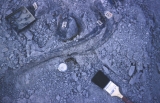 |
Two ribs and caudal vertebrae, Allosaurus (UUVP 0261, 0106, 0012). | 1950; 1951; 1952; 1953; 1954; 1955; 1956; 1957; 1958; 1959; 1960; 1961; 1962; 1963; 1964; 1965; 1966; 1967; 1968; 1969; 1970; 1971; 1972; 1973; 1974; 1975; 1976; 1977; 1978; 1979; 1980; 1981; 1982; 1983; 1984; 1985; 1986; 1987; 1988; 1989; 1990; 1991; 1992; 1993; 1994; 1995; 1996; 1997; 1998; 1999 | Image |
| 78 |
 |
Uncommon association of two articulating limb elements, femur and tibia of Allosaurus (UUVP 0826, 0827). | 1950; 1951; 1952; 1953; 1954; 1955; 1956; 1957; 1958; 1959; 1960; 1961; 1962; 1963; 1964; 1965; 1966; 1967; 1968; 1969; 1970; 1971; 1972; 1973; 1974; 1975; 1976; 1977; 1978; 1979; 1980; 1981; 1982; 1983; 1984; 1985; 1986; 1987; 1988; 1989; 1990; 1991; 1992; 1993; 1994; 1995; 1996; 1997; 1998; 1999 | Image |
| 79 |
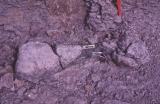 |
Unidentified. | 1950; 1951; 1952; 1953; 1954; 1955; 1956; 1957; 1958; 1959; 1960; 1961; 1962; 1963; 1964; 1965; 1966; 1967; 1968; 1969; 1970; 1971; 1972; 1973; 1974; 1975; 1976; 1977; 1978; 1979; 1980; 1981; 1982; 1983; 1984; 1985; 1986; 1987; 1988; 1989; 1990; 1991; 1992; 1993; 1994; 1995; 1996; 1997; 1998; 1999 | Image |
| 80 |
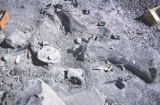 |
Vertebrae, ischium, and tibia, Camarasaurus (?) (UUVP 2426-tibia). | 1950; 1951; 1952; 1953; 1954; 1955; 1956; 1957; 1958; 1959; 1960; 1961; 1962; 1963; 1964; 1965; 1966; 1967; 1968; 1969; 1970; 1971; 1972; 1973; 1974; 1975; 1976; 1977; 1978; 1979; 1980; 1981; 1982; 1983; 1984; 1985; 1986; 1987; 1988; 1989; 1990; 1991; 1992; 1993; 1994; 1995; 1996; 1997; 1998; 1999 | Image |
| 81 |
 |
Vertebrae, ribs, etc., Allosaurus (UUVP 0012, 0106, 0261, 0262, 0267). | 1950; 1951; 1952; 1953; 1954; 1955; 1956; 1957; 1958; 1959; 1960; 1961; 1962; 1963; 1964; 1965; 1966; 1967; 1968; 1969; 1970; 1971; 1972; 1973; 1974; 1975; 1976; 1977; 1978; 1979; 1980; 1981; 1982; 1983; 1984; 1985; 1986; 1987; 1988; 1989; 1990; 1991; 1992; 1993; 1994; 1995; 1996; 1997; 1998; 1999 | Image |
| 82 |
 |
View from above, looking south(?). | 1950; 1951; 1952; 1953; 1954; 1955; 1956; 1957; 1958; 1959; 1960; 1961; 1962; 1963; 1964; 1965; 1966; 1967; 1968; 1969; 1970; 1971; 1972; 1973; 1974; 1975; 1976; 1977; 1978; 1979; 1980; 1981; 1982; 1983; 1984; 1985; 1986; 1987; 1988; 1989; 1990; 1991; 1992; 1993; 1994; 1995; 1996; 1997; 1998; 1999 | Image |
| 83 |
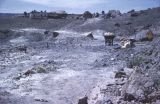 |
View from the quarry, looking south with the 1961 trailer Accommodation in the background. | 1961 | Image |
| 84 |
 |
View of the sizeable crowd turned out for the dedication. | 1960; 1961; 1962; 1963; 1964; 1965; 1966; 1967; 1968; 1969; 1970; 1971; 1972; 1973; 1974; 1975; 1976; 1977; 1978; 1979 | Image |
| 85 |
 |
The Visitor Center at the C-LDQ, which became a United States Natural Landmark in 1968, has some interesting graphics that interpret and detail the operation and history of the Quarry. Included in the exhibits are some prepared, original dinosaur bones, and a mounted free- standing skeleton of a medium-sized Allosaur, which consists of less than 50% of the original, fossil bones. The skull of the Allosaur can be seen through the window in the front of the building. | 1970; 1971; 1972; 1973; 1974; 1975; 1976; 1977; 1978; 1979; 1980; 1981; 1982; 1983; 1984; 1985; 1986; 1987; 1988; 1989; 1990; 1991; 1992; 1993; 1994; 1995; 1996; 1997; 1998; 1999 | Image |
| 86 |
 |
Duane Stone (U of U, Geology student). | 1960; 1961; 1962; 1963; 1964; 1965; 1966; 1967; 1968; 1969; 1970; 1971; 1972; 1973; 1974; 1975; 1976; 1977; 1978; 1979 | Image |
| 87 |
 |
Duane Stone (U of U, Geology student). | 1960; 1961; 1962; 1963; 1964; 1965; 1966; 1967; 1968; 1969; 1970; 1971; 1972; 1973; 1974; 1975; 1976; 1977; 1978; 1979 | Image |
| 88 |
 |
During the 1960s at Fort Douglas, east of Salt Lake City, Utah was a World War II, army barracks, no longer standing on the upper University of Utah Campus, known as the "Bone Barn". It was the first "home" of the extensive bone inventory collected from the Cleveland-Lloyd Dinosaur Quarry. More than 60% of the original collection remained in Utah after the commitments to supporting institutions were met. These institutions had provided financial support for excavation, preparation, and research to the University of Utah Cooperative Dinosaur Project from 1960 to 1968. (June 1968) | 1968-06 | Image |
| 89 |
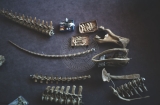 |
The entire mount is prepared in segments and modules that facilitate easy transportation, handling, and assembly. | 1968-10 | Image |
| 90 |
 |
Femur?, unidentified taxon. | 1950; 1951; 1952; 1953; 1954; 1955; 1956; 1957; 1958; 1959; 1960; 1961; 1962; 1963; 1964; 1965; 1966; 1967; 1968; 1969; 1970; 1971; 1972; 1973; 1974; 1975; 1976; 1977; 1978; 1979; 1980; 1981; 1982; 1983; 1984; 1985; 1986; 1987; 1988; 1989; 1990; 1991; 1992; 1993; 1994; 1995; 1996; 1997; 1998; 1999 | Image |
| 91 |
 |
Foothill Junior College students, circa 1976. | 1960; 1961; 1962; 1963; 1964; 1965; 1966; 1967; 1968; 1969; 1970; 1971; 1972; 1973; 1974; 1975; 1976; 1977; 1978; 1979 | Image |
| 92 |
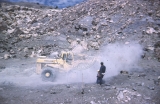 |
For nearly 20 years following the initial Quarry opening by the University of Utah Cooperative Dinosaur Project in 1960, it was necessary to open and close the Quarry with heavy equipment each field season to protect it from vandalism and illegal collecting. (October 1961) | 1961-10 | Image |
| 93 |
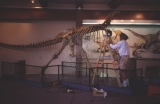 |
The forearms are pinned in place after the dorsal ribs have been attached. | 1968-10 | Image |
| 94 |
 |
The fossiliferous unit at the C-LDQ, which consists of poorly stratified to blocky, bentonitic shales, is overlain by a dense, hard, siliceous, freshwater limestone. The surface between the two units shows evidence of channeling as seen here. (June 1961) | 1961-06 | Image |
| 95 |
 |
Fragments of a right ilium, Allosaurus. | 1950; 1951; 1952; 1953; 1954; 1955; 1956; 1957; 1958; 1959; 1960; 1961; 1962; 1963; 1964; 1965; 1966; 1967; 1968; 1969; 1970; 1971; 1972; 1973; 1974; 1975; 1976; 1977; 1978; 1979; 1980; 1981; 1982; 1983; 1984; 1985; 1986; 1987; 1988; 1989; 1990; 1991; 1992; 1993; 1994; 1995; 1996; 1997; 1998; 1999 | Image |
| 96 |
 |
Full scale replicas of two Allosaurus sculpted by David Thomas, a well- known dinosaur artist who worked in Albuquerque, New Mexico. | 1960; 1961; 1962; 1963; 1964; 1965; 1966; 1967; 1968; 1969; 1970; 1971; 1972; 1973; 1974; 1975; 1976; 1977; 1978; 1979 | Image |
| 97 |
 |
The fused caudal vertebrae and a chevron of Allosaurus show extensive pathology involving the transverse process of the right side. Traumas to the tails of dinosaurs are among the more common pathologies. | 1960; 1961; 1962; 1963; 1964; 1965; 1966; 1967; 1968; 1969; 1970; 1971; 1972; 1973; 1974; 1975; 1976; 1977; 1978; 1979 | Image |
| 98 |
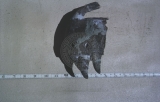 |
Fused premaxillae of Ceratosaurus, left lateral view. | 1960; 1961; 1962; 1963; 1964; 1965; 1966; 1967; 1968; 1969; 1970; 1971; 1972; 1973; 1974; 1975; 1976; 1977; 1978; 1979 | Image |
| 99 |
 |
Here is a scientific illustration of the skull of Camarasaurs lentus. Superior illustrations often are the most important part of a paper presenting a scientific description of a fossil bone, because they allow interpretation, not always possible, even with the best photographs. (March 1994) | 1994-03 | Image |
| 100 |
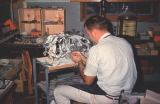 |
Here is the backlighted braincase of Camarasaurus, which was projected at 2/3 natural size on a sheet of drawing paper. Next, a sketch would be made noting the complete outline and all features. This sketch would be used by the artist, as a basis for the illustration needed for a scientific publication. The sketch would be reduced 50% for a printed size of 1/3 scale. (May 1984) | 1984-05 | Image |
